#laser scan to bim models
Explore tagged Tumblr posts
Text
Accelerating Process with Scan to BIM for As-Built Modeling

BIM adoption has altered the AEC industry with accurate outcomes for construction projects. Integrated with laser scanning, scan to BIM brings a revolution in renovation projects, allowing professionals to improve the complex process. Here’s how scan to BIM as-built process helps experts in renovation project efficiency.
#scan to bim services#point cloud to bim#point cloud to bim services#laser scan to bim#point cloud modeling services#scan to bim company#scan to bim modeling#scan to bim modeling services#point cloud scan to bim
3 notes
·
View notes
Text
What Is Scan to BIM? Benefits for Architects and Engineers

In today’s fast-evolving AEC (Architecture, Engineering, and Construction) industry, the demand for high-precision, time-saving, and cost-effective digital solutions is higher than ever. One revolutionary process transforming the way professionals work is Scan to BIM. With the fusion of 3D laser scanning and Building Information Modeling (BIM), Scan to BIM provides an accurate digital representation of a building’s current conditions — a game-changer for architects, engineers, and construction firms.
This article explores what Scan to BIM is, how it works, and why it is invaluable to professionals in architecture and engineering.
Understanding Scan to BIM

Scan to BIM is the process of capturing a physical building or site using 3D laser scanning and then converting the collected data (known as a point cloud) into a digital BIM model. This model can be used for planning renovations, retrofitting, documentation, or creating as-built conditions for construction.
This process typically involves:
3D Laser Scanning of a site or building using LiDAR equipment.
Processing the scan data into a point cloud to BIM workflow.
Converting point cloud data into a usable 3D BIM model using tools like Scan to BIM Revit.
Professionals can then use these models to streamline design, coordination, and construction phases.
Benefits of Scan to BIM for Architects
1. Accurate As-Built Documentation
One of the key benefits of Scan to BIM for architects is the generation of highly accurate as-built models. These models reflect the exact current conditions of a building, removing guesswork and reducing design errors. This is particularly useful for complex renovation or restoration projects where architectural drawings may be outdated or missing.
2. Design Precision and Efficiency
Working from a precise BIM model saves architects time and helps ensure their designs fit seamlessly into existing structures. This level of accuracy enhances project quality and minimizes costly rework, particularly when working with older or structurally unique buildings.
3. Enhanced Collaboration
Architects often work in collaboration with engineers, contractors, and stakeholders. With Scan to BIM services, they can share an exact digital replica of the building, making coordination more transparent and reducing miscommunication.
Benefits of Scan to BIM for Engineers
1. Structural Analysis and Load Assessment
Scan to BIM modeling services provide engineers with accurate geometry that is crucial for performing structural analysis and load assessment. Whether designing additional structural elements or verifying the stability of an existing framework, having a detailed BIM model streamlines the process.
2. Clash Detection and Coordination
Using 3D scan to BIM tools, engineers can identify clashes between different building systems early in the design process. Whether it's MEP, HVAC, or structural elements, engineers can address conflicts proactively.
3. Integration with Simulation Tools
BIM models generated from 3D laser scanning in construction are compatible with many simulation and analysis platforms. This allows engineers to perform energy modeling, load calculations, or environmental simulations more effectively.
Use Cases of Scan to BIM in the AEC Industry
Scan to BIM is not just a niche tool; it has widespread applications across various sectors:
1. Renovations and Retrofit Projects
Historic buildings or older structures with little documentation can benefit greatly from 3D laser scanning BIM processes. Architects can create reliable renovation plans by referencing highly accurate as-built models.
2. Facility and Asset Management
Facilities teams use BIM models for ongoing operations, maintenance, and asset tracking. With point cloud to BIM conversions, they get a comprehensive digital twin of the facility that’s easy to update and manage.
3. Heritage Preservation
Historical architecture requires meticulous detail. With Scan to BIM Revit, preservationists and architects can document every corner and crevice, maintaining the integrity of these priceless structures digitally.
4. Construction Verification
3D scan to BIM allows teams to verify if the construction is proceeding according to plan. Any discrepancies between the planned and actual construction can be spotted early, saving time and money.
Workflow: From Scanning to BIM Modeling
The typical scan to BIM workflow includes the following stages:
3D Laser Scanning: A laser scanner captures millions of data points in a space, creating a dense point cloud.
Registration: Multiple scans are combined into a unified dataset.
Point Cloud Cleaning: The scan data is cleaned to remove unnecessary elements like people or moving objects.
Conversion to BIM: Specialists convert the cleaned point cloud into a BIM model using tools like Revit, tailored to the desired Level of Detail (LOD).
Model Usage: The model is then used for design, documentation, simulation, or facility management.
Each stage is crucial and contributes to the accuracy of the final model.
Why Scan to BIM Revit Is Industry Standard
Scan to BIM Revit has become the industry standard due to its wide acceptance and integration capabilities. Revit allows seamless coordination between architects, structural engineers, and MEP professionals. The platform supports advanced modeling, clash detection, and scheduling features.
With plugins and workflows specifically designed for scan to BIM services, Revit makes it easier to translate point cloud data into intelligent building elements.
Advancements in Scan to BIM: The Role of BIM AR
One exciting development in the Scan to BIM space is the integration of BIM AR (Augmented Reality). Using AR technology, professionals can overlay BIM models directly onto physical spaces using smartphones or headsets. This innovation allows real-time, on-site validation, making project planning and verification even more efficient.
For example, architects can walk through a building and see proposed changes virtually overlaid onto the existing structure. Engineers can perform real-time clash checks in the field, enhancing decision-making and reducing site visits.
Choosing the Right Scan to BIM Services Provider
If you’re looking to implement scan to BIM in your next project, here are some factors to consider when selecting a provider:
Experience and Portfolio: Look for companies with extensive experience in your industry.
Software Expertise: Make sure they are proficient in tools like Revit, AutoCAD, and other BIM platforms.
Quality Assurance: Check if they follow rigorous quality standards in their modeling.
Customization Options: The ability to tailor models to specific LOD requirements is crucial.
SmartCADD is a trusted name in the industry, offering high-quality scan to BIM modeling services with attention to accuracy, customization, and detail.
Future of Scan to BIM
As the industry embraces digital transformation, Scan to BIM will play an increasingly vital role in how buildings are designed, constructed, and maintained. Emerging trends such as AI-assisted modeling, cloud collaboration, and BIM AR are poised to elevate the process further.
Automation tools are being developed to streamline point cloud to BIM conversions, making the process faster and more accessible. Additionally, tighter integration between scanning hardware and modeling software will reduce time from scan to model, improving project agility.
Final Thoughts
Scan to BIM is reshaping how architectural and engineering professionals work with existing structures. From improving accuracy and design coordination to streamlining renovation and facility management, the advantages are numerous and practical.
Understanding the fundamentals of the process—from 3D laser scanning to BIM model creation—helps ensure its effective application in real-world projects. If you're exploring how to adopt this method into your workflow, learning more about its real-life benefits is essential. A great starting point is SmartCADD's detailed overview of Scan to BIM and its benefits, which provides a deeper dive into use cases and industry-specific insights.
As more firms embrace digital transformation, the role of scan to BIM services will only expand���delivering smarter, safer, and more efficient outcomes across the built environment.
#Scan to bim#scan to bim services#scan to bim modeling services#3d laser scanning bim#3d scan to bim#point cloud to bim#bim ar#3d laser scanning in construction#scan to bim revit
0 notes
Text
We specialize in offering cutting-edge 3D BIM modeling services in USA to the AEC industry. Whether you are working on new construction, renovations, or retrofitting projects, our AI-powered tools ensure the delivery of high-quality 3D modeling for construction. With extensive experience in 3D laser scan to BIM conversion, we provide highly accurate and data-rich BIM outputs that empower better decisions.
#3D BIM modeling services in USA#3D laser scan to BIM conversion#3D laser scan to BIM#3D laser scan to BIM Modeling Services#3D BIM Modeling
0 notes
Text





#construction#laser scanning#3d laser scanning#virginia#bim#3d scanning#building information modeling#building design#as built drawing#as built documenation
0 notes
Text
#3d laser scanning#bim modeling services#Stockpile 3D Scanning Survey#3D Modeling#revit modeling services
0 notes
Text
youtube
Building Information Modelling is becoming an inseparable part of the daily lives of those who belongs to Architectural Engineering Construction and Operation (AECO) industry but remains shrouded in mystery to many stakeholders involved.
Before elaborating the some common myths about BIM and truth let’s find out “What is BIM?” first.
The entire process of creating and managing information for a built object is known as Building Information Modeling (BIM). BIM generates intelligent cloud-based model integrating multi-disciplinary structured data to build a digital visualization of an object throughout its lifecycle from conceptual and designing stage to construction and operations.
0 notes
Text
Transforming Indian Architectural Renovations with Laser Scanning Technology
In recent years, the field of architectural renovations in India has witnessed a transformative shift with the advent of laser scanning technology. This advanced technology, often referred to as LiDAR (Light Detection and Ranging), offers unprecedented accuracy and efficiency in capturing the intricate details of existing structures, thereby revolutionizing how renovations are planned and executed.
Precision and Accuracy
One of the most significant advantages of laser scanning technology is its ability to capture precise measurements and detailed 3D models of existing structures. Traditional surveying methods, while effective, often fall short of capturing the intricate details and nuances of complex architectural designs. Laser scanning, however, uses millions of laser points to create highly accurate and detailed representations of buildings. This precision ensures that renovation plans are based on exact measurements, reducing the risk of errors and discrepancies during the construction phase.
Time and Cost Efficiency
Laser scanning technology significantly reduces the time required for site surveys. Traditional methods can be time-consuming and labor-intensive, often requiring multiple visits to the site. In contrast, laser scanning can capture comprehensive data in a single visit, speeding up the surveying process. This efficiency translates to cost savings, as fewer resources are needed for data collection and fewer revisions are required due to inaccuracies in initial measurements.
Improved Planning and Visualization
The detailed 3D models generated by laser scanning technology enhance the planning and visualization of renovation projects. Architects and designers can explore the existing structure in a virtual environment, allowing them to identify potential challenges and opportunities before the construction begins. This level of visualization aids in better decision-making and facilitates communication with clients and stakeholders, who can easily understand and visualize the proposed changes.
Related blog: How Laser Scanning Solution Can Help In Renovation Projects Of Indian Architecture Buildings?
Enhanced Documentation and record-keeping
Laser scanning provides a comprehensive and permanent record of the existing conditions of a structure. This digital documentation is invaluable for future reference, maintenance, and further renovations. Having an accurate digital archive ensures that any modifications or repairs are based on reliable data, reducing the risk of unforeseen issues and preserving the architectural integrity of the building.
Sustainability and Preservation
In the context of heritage buildings and historical sites, laser scanning technology plays a crucial role in preservation. Many of India’s architectural treasures require careful and precise restoration to maintain their historical significance. Laser scanning allows for non-invasive documentation of these structures, capturing their current state without causing any damage. This technology ensures that renovations and restorations are carried out with utmost respect for the original design and materials, preserving the cultural heritage for future generations.
Conclusion
Laser scanning technology is revolutionizing architectural renovations in India by providing precise measurements, enhancing planning and visualization, improving efficiency, and aiding in preserving historical structures. As the adoption of this technology continues to grow, it promises to transform the landscape of architectural renovations, ensuring that India’s built heritage is preserved and enhanced for generations to come.
0 notes
Text
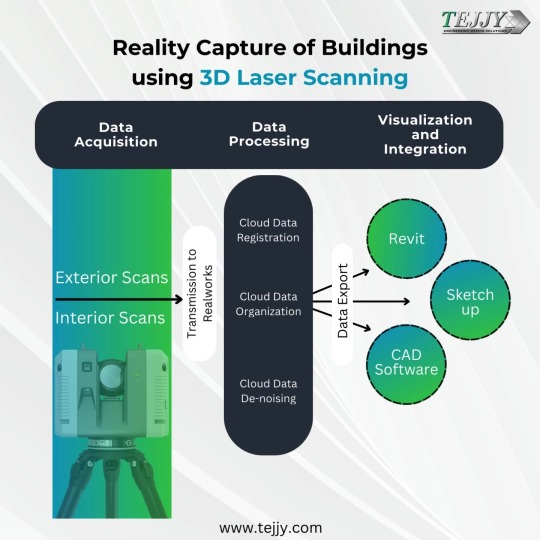
Reality capture, also known as 3D laser scanning, is a powerful technology used to create highly detailed and accurate digital representations of buildings.
Applications of Reality Capture in Buildings:
Construction: Creates as-built models for verification, clash detection (identifying conflicts between building elements), and progress monitoring.
Renovations: Provides accurate documentation of existing conditions before renovation work begins.
Facility Management: Enables efficient space planning, maintenance scheduling, and asset tracking.
Historic Preservation: Creates digital archives of historical buildings for preservation purposes.
Overall, reality capture with 3D laser scanning offers a faster, more accurate, and more efficient way to capture and document building data for various applications.
0 notes
Text
Redefining Digital Twin Technology with Scan to BIM Services

Digital twin technology has become a crucial part of the AEC industry, allowing experts to visualise better and ensure the overall performance efficiency. With laser scanning to BIM technology, digital twin modeling becomes accurate, here’s how it redefines.
#scan to bim services#point cloud to bim#point cloud to bim services#laser scan to bim#point cloud modeling services#scan to bim company#scan to bim modeling#scan to bim modeling services#point cloud scan to bim
2 notes
·
View notes
Text
Discover how Scan-to-BIM modeling transforms the construction process by improving accuracy and efficiency. Learn how this cutting-edge technology converts laser-scanned data into detailed 3D models, enabling better project visualization, clash detection, and seamless collaboration across design and construction teams.
#3D Laser Scanning#3D Scan to BIM#BIM Modeling#BIM Technology#Building Information Modeling#Scan to BIM#scan to bim services
1 note
·
View note
Text
Scan to CAD and point cloud to BIM modeling services
Introduction:
In the dynamic realm of architecture, engineering, and construction (AEC), leveraging cutting-edge technologies is paramount for efficiency, accuracy, and innovation. One such transformative process gaining significant traction is Scan to CAD and Point Cloud to BIM Modeling Services. These services offer a bridge between physical reality and digital design, revolutionizing traditional workflows and opening avenues for unprecedented precision and creativity. Scan to CAD and Point Cloud to BIM modeling services have emerged as transformative tools, revolutionizing how professionals conceptualize, design, and execute projects.
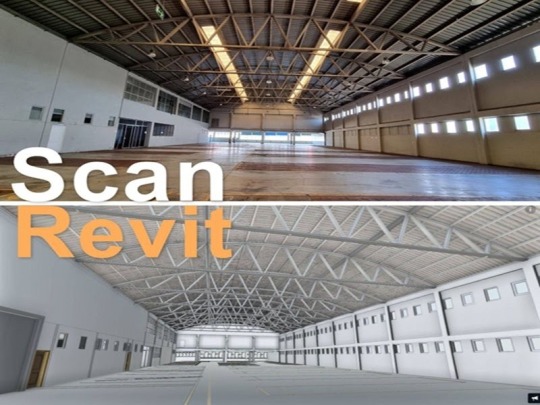
Introduction to Scan to CAD and Point Cloud to BIM Modeling Services:
Scan to CAD involves the conversion of scanned data from physical objects or environments into Computer-Aided Design (CAD) files. On the other hand, Point Cloud to Building Information Modeling (BIM) entails the transformation of three-dimensional point cloud data into intelligent BIM models. These services collectively offer a comprehensive solution for modern design challenges. Scan to CAD processes capture detailed spatial information of physical structures with remarkable precision. This data is then transformed into digital CAD models, providing designers and engineers with a comprehensive virtual representation of the scanned environment.
Enhanced Accuracy and Precision:
One of the key advantages of Scan to CAD and Point Cloud to BIM Modeling Services is their ability to capture intricate details with unparalleled accuracy. By utilizing advanced scanning technologies such as LiDAR (Light Detection and Ranging) and photogrammetry, every nuance of the physical environment can be accurately captured and translated into digital models, ensuring precise representation in the design phase.
Efficiency and Time Savings:
Traditional methods of manual measurement and drafting are not only time-consuming but also prone to errors. Scan to CAD and Point Cloud to BIM services streamline the design process by significantly reducing the time required for data acquisition and model generation. This efficiency translates into faster project delivery timelines and cost savings for stakeholders.
Seamless Integration with Existing Workflows:
These services seamlessly integrate with existing design workflows, enhancing collaboration among architects, engineers, and construction professionals. The compatibility of CAD and BIM models ensures smooth communication and data exchange throughout the project lifecycle, from conceptualization to construction and beyond.
Improved Visualization and Analysis:
By converting point cloud data into intelligent BIM models, designers gain access to powerful visualization and analysis tools. This enables them to explore different design scenarios, conduct clash detection, and simulate real-world conditions with greater accuracy, leading to informed decision-making and optimized design outcomes. Facilitating Renovation and Retrofit Projects:
Scan to CAD and Point Cloud to BIM services are particularly valuable for renovation and retrofit projects where accurate as-built documentation is essential. By capturing existing conditions in detail and creating precise digital models, designers can seamlessly integrate new elements into existing structures, minimizing disruptions and maximizing efficiency.
Supporting Sustainable Design Practices:
The ability to accurately assess existing building conditions and visualize the impact of design changes contributes to sustainable design practices. By optimizing energy efficiency, material usage, and building performance, Scan to CAD and Point Cloud to BIM Modeling Services play a crucial role in creating environmentally conscious and resource-efficient structures.
Enhancing Safety and Risk Mitigation:
Accurate documentation of existing conditions through point cloud scanning reduces safety risks associated with site visits and manual measurements. Moreover, by identifying potential clashes and design inconsistencies early in the process, these services help mitigate construction errors and costly rework, enhancing overall project safety and quality.
Adapting to Evolving Industry Trends:
As the AEC industry continues to embrace digital transformation, Scan to CAD and Point Cloud to BIM Modeling Services are poised to play an increasingly integral role. From augmented reality (AR) and virtual reality (VR) applications to the integration of artificial intelligence (AI) for automated modeling tasks, the possibilities for innovation are vast and evolving.
Conclusion:
Rvtcad represents Scan to CAD, and Point Cloud to BIM Modeling Services represents a paradigm shift in the way architectural and construction projects are conceived, designed, and executed. By harnessing the power of advanced scanning technologies and intelligent modeling algorithms, these services empower designers to push the boundaries of creativity while ensuring accuracy, efficiency, and sustainability in every project they undertake. Embracing these transformative capabilities is not just a choice but a necessity for staying competitive in today's rapidly evolving AEC landscape.
#Scan to cad#point cloud to bim modeling#scan to bim#point cloud to bim#bim services#3d laser scanning#bim laser scanning#scan to revit#as-built drawing#as-built drawings#point cloud to cad
0 notes
Text
#scan to bim#construction#building information modeling#3d laser scanning#bim#architecture#traditional surveying#laser scanning
0 notes
Text
Get the Best Laser Scan to BIM Services in Bristol, UK
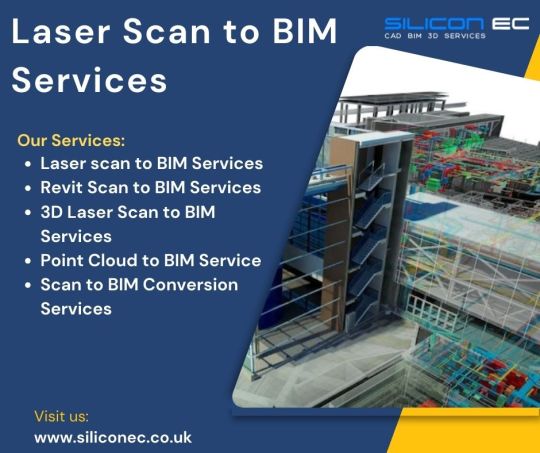
Silicon EC UK Limited offers comprehensive Laser Scan to BIM Services in Bristol, UK, catering to the evolving needs of the construction and architectural industries. Our experienced team of engineers and BIM specialists transforms raw scan data into intelligent 3D models, seamlessly integrating them into the BIM environment. Our team of experienced professionals utilizes state-of-the-art equipment to conduct comprehensive laser scans, generating highly detailed point clouds that serve as the foundation for creating accurate 3D models. Our services empower clients to streamline project planning, enhance construction coordination, and minimize errors, ultimately leading to improved project outcomes and cost savings. Our commitment to excellence, combined with a collaborative approach, ensures seamless communication and transparency at every stage of the BIM project.
Supports and software facility:
Our dedicated workforce comprises steadfast QC heads, proficient Team Leads, and experienced Engineers who possess extensive expertise. Our BIM Services adeptly utilize cutting-edge software, including AutoCAD, Tekla Structure, and Revit Structure, showcasing a commitment to staying at the forefront of technological advancements.
We are a BIM Engineering Company that presents BIM Engineering Services Bristol and other cities covering London, Liverpool, Manchester, York, Leeds-Bradford, Glasgow, Newcastle, Sheffield, and Sunderland.
Choose Silicon EC UK Limited for comprehensive Laser Scan to BIM Services in Bristol, UK, and experience the difference in precision, reliability, and innovation for your next Building project.
For More Details Visit our Website:
#Laser Scan to BIM Services#Revit Scan to BIM Services#3D Laser Scan to BIM Services#Point Cloud to BIM Service#Scan to BIM Conversion Services#Scan to BIM Services#BIM Services#Building Information Modeling Services#Building Information Modeling#BIM#BIM Services Bristol#BIM Engineering Services UK#BIM Services UK#Laser Scan to BIM Services Bristol#Scan to BIM Services UK#CAD Design#CAD Drafting#CAD Drawing#Engineering Services#Engineering Company#Engineering Firm
0 notes
Text
The Significance of Outsourced BIM Clash Detection Services
The construction industry is undergoing a digital revolution, and at the heart of this transformation is Building Information Modeling (BIM). BIM is not just a buzzword; it's a game-changer that offers a holistic and collaborative approach to construction projects. In this article, we'll explore a crucial aspect of BIM—clash detection—and how outsourcing this service can significantly impact project success.

What is BIM Clash Detection?
Building Information Modeling (BIM) clash detection is a critical process in modern construction projects. It involves the use of 3D models to identify and resolve clashes or conflicts among various building components such as structural elements, plumbing, electrical systems, and HVAC. This process helps prevent costly errors, design inconsistencies, and construction delays.
BIM clash detection operates on the premise that it's much more efficient to catch issues in the virtual realm rather than encountering them on the construction site. By simulating the entire project digitally, potential issues can be discovered and rectified before they become real-world problems.
The Benefits of BIM Clash Detection
The advantages of implementing BIM clash detection in construction projects are multifaceted. First and foremost, it leads to cost savings. By addressing clashes early in the design phase, you can avoid costly on-site modifications and rework. The efficient identification and resolution of issues also reduce construction delays, leading to projects being completed on time or even ahead of schedule.
Furthermore, BIM clash detection significantly enhances the overall project quality. It minimizes the risk of human error, ensuring that the building's systems fit together seamlessly. This, in turn, enhances the safety and functionality of the constructed facility.
Collaboration is another key benefit. BIM clash detection encourages better communication and cooperation among various project stakeholders, including architects, engineers, contractors, and subcontractors. It promotes a culture of shared responsibility and problem-solving, which is vital for project success.
Challenges in In-House Clash Detection
While BIM clash detection offers numerous advantages, many construction firms face limitations when attempting to perform it in-house. One significant challenge is the requirement for specialized skills and expertise. Skilled BIM modelers and clash detection experts are not always readily available within an organization.
Another constraint is the necessary technology and software. Building and maintaining a high-quality BIM environment with the right software tools can be costly and resource-intensive. Smaller firms, in particular, may struggle to make this investment.
The Role of Outsourced BIM Clash Detection Services
Outsourcing BIM clash detection services offers a compelling solution to the challenges faced by construction firms. Outsourcing firms specialize in BIM and have dedicated teams with expertise in clash detection.
These outsourced teams bring state-of-the-art technology and software to the table, ensuring that projects benefit from the latest advancements in the field. Additionally, by outsourcing, construction firms can scale their clash detection capabilities up or down as needed without making significant investments in technology and personnel.
Outsourcing providers typically have a track record of successful projects and the experience to handle complex scenarios effectively. This level of expertise can be a game-changer for construction projects, especially when dealing with intricate, large-scale developments.
Key Considerations when Outsourcing Clash Detection
When considering outsourcing BIM clash detection services, there are essential factors to keep in mind. First and foremost, evaluate the outsourcing partner's experience and reputation. Look for a provider with a proven track record of delivering high-quality clash detection services on time and within budget.
Additionally, consider the technology capabilities of the outsourcing firm. Ensure they have the latest BIM software and tools, and can seamlessly integrate with your existing project management systems.
Effective communication and collaboration are crucial in outsourcing relationships. Establish clear lines of communication and expectations with your outsourcing partner. Collaborate closely to ensure that your project's specific needs and goals are met.
Conclusion:
In conclusion, outsourced BIM clash detection services are a vital component of successful construction projects in the digital age. The benefits of early conflict identification, cost savings, improved project quality, and enhanced collaboration cannot be overstated. While in-house clash detection has its limitations, outsourcing provides access to specialized expertise and cutting-edge technology. By carefully selecting the right outsourcing partner, construction firms can ensure that their BIM projects proceed with efficiency, accuracy, and success. Consider outsourcing as a strategic move to elevate your construction projects to the next level.
Visit us: https://www.bimengus.com/clash-detection-services
#bim coordination services#laser scanning services#bimtechnology#bim modeling services#mep services#architecture
1 note
·
View note
Text
How 3D Scanning Helps to Preserve Historical Buildings?
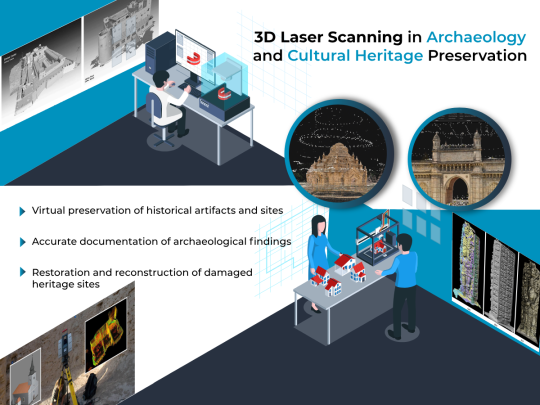
From Crumbling Castles to Digital Cathedrals: How 3D Scanning Protects History's Gems?
Have you ever walked through a historic building and wondered how it weathered centuries of storms and wear-and-tear? Preservationists face a constant battle against time, decay, and even well-meaning renovations that can erase vital details. But now, thanks to 3D Laser Scanning Services, these magnificent structures are finally getting the high-tech TLC they deserve.
What Is 3D Laser Scanning Technology?
So, how exactly does this magic wand of technology work? Well, think of lidar scanning like a super-powered camera that shoots millions of laser beams, mapping every nook and cranny of a building with millimeter precision. It's like taking a digital fingerprint of history, capturing every intricate detail from weathered stonework to ornate moldings.
How is laser scanning used for historic preservation?
But scanning is just the first step. These raw point clouds then get transformed into 3D BIM models, breathing life back into ancient structures. Think of it as building a virtual twin of the real thing, complete with dimensions, materials, and even hidden structural elements. This isn't just a pretty picture; it's a powerful tool for heritage & preservation.
Laser Scanning and Reverse Engineering:
With 3D Laser Scanning Services and Reverse Engineering Services, architects and engineers can analyze ancient structures like never before. They can identify cracks, assess potential damage, and even plan meticulous restorations, ensuring every brick and beam is preserved with historical accuracy. Think about uncovering hidden passageways or reconstructing lost sections with near-perfect fidelity!
Laser Scanning and Architectural Rendering:
Beyond restoration, 3D Laser Scanning Services and Architectural Rendering offer a whole new realm of possibilities. Think about creating stunning virtual tours that transport visitors back in time, or even using the scans to produce museum-quality replicas for exhibitions around the world. It's like bringing history to life, pixel by pixel.
This incredible technology isn't just about fancy gadgets; it's about preserving the stories etched in our built environment. Every weathered wall and crumbling arch whispers tales of the past, and The Vital Role of Laser Scanning in Heritage Conservation ensures those voices aren't silenced. It's a legacy project, safeguarding the tangible remnants of our shared history for generations to come.
Time Becomes a Treasure: How BIM Safeguards History with a Digital Touch?
Think of venturing into a crumbling castle, not to witness decay, but to witness its potential for resurrection. Here comes BIM (Building Information Modeling) in Heritage & Preservation. With 3D Laser Scanning Services, meticulously detailed point clouds become the building blocks of history's revival.
Think of lidar 3d scanning as a time capsule, capturing every crack, curve, and inscription like a digital archaeologist. These intricate scans, transformed into 3D BIM models, become virtual twins of the real thing, preserving every architectural whisper from weathered stonework to hidden frescoes. This isn't just a pretty picture; it's a powerful tool for Historic Preservation 3D Laser Scanning and Modeling.
With pinpoint accuracy, engineers and architects can assess structural integrity, identify potential dangers, and plan meticulous restorations. Building Information Modeling uncovers hidden passageways through scan analysis or reconstructing lost sections with laser-guided precision. Every brick and beam is treated with historical reverence, ensuring authenticity in every restoration step.
However, the Vital Role of Laser Scanning in Heritage Conservation extends beyond repairs. 3D Laser Scanning Services and Architectural Rendering bring history to life through immersive virtual tours and museum-quality replicas. Walk through ancient temples in VR, explore forgotten chambers, or marvel at detailed models in exhibitions across the globe. It's a democratization of history, making its grandeur accessible to all.
BIM in heritage isn't just about technology; it's about respect and responsibility. It's about understanding the stories etched in every archway and preserving them for future generations. With digital guardians like 3D Laser Scanning Services and Point Clouds, the whispers of the past echo louder than ever.
So, the next time you wander through a timeworn masterpiece, remember the quiet heroes working behind the scenes. BIM 3D Scanning Services are giving history a second chance, ensuring these architectural marvels not only survive, but thrive in the digital age. And who knows, maybe one day, thanks to this technology, we'll finally crack the code of those ancient mysteries hidden within their walls. To know more on scan to BIM or 3D laser scanning, talk to the proficient BIM consultants in USA.
#3D Laser Scanning Services#3D Laser Scanning Technology#BIM 3D Scanning Services#Lider 3D Scanning#Historic Preservation 3D Laser Scanning and Modeling#construction#architecture#maryland#florida#New York#business#usa#3D Laser Scanning Tejjy Price#Tejjy Inc
1 note
·
View note
Text
Exploring the Diverse Landscape of BIM Software in Construction: A Comprehensive Guide
Introduction: In the ever-evolving field of construction, Building Information Modeling (BIM) has emerged as a transformative technology that revolutionizes the way buildings are designed, constructed, and managed. BIM software plays a pivotal role in enhancing collaboration, improving efficiency, and minimizing errors throughout the construction process. This article delves into the various…
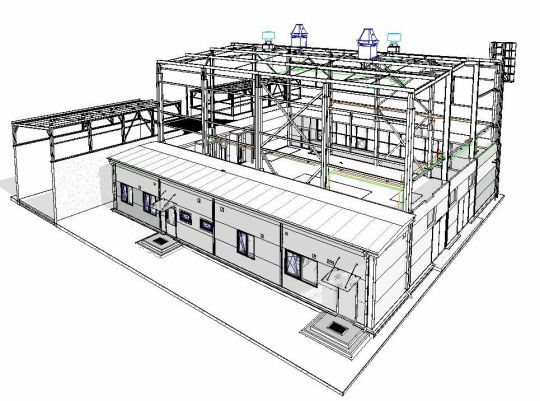
View On WordPress
#architectural design software#as-built documentation#BIM model accuracy#BIM software#Building Information Modeling#collaboration platforms#construction industry advancements#construction management software#construction project efficiency#Construction Technology#cost estimation tools#facility maintenance optimization#facility management solutions#laser scanning technology#LiDAR applications#MEP systems modeling#point cloud integration#project stakeholders collaboration#real-time coordination#structural engineering tools#sustainable building practices
0 notes